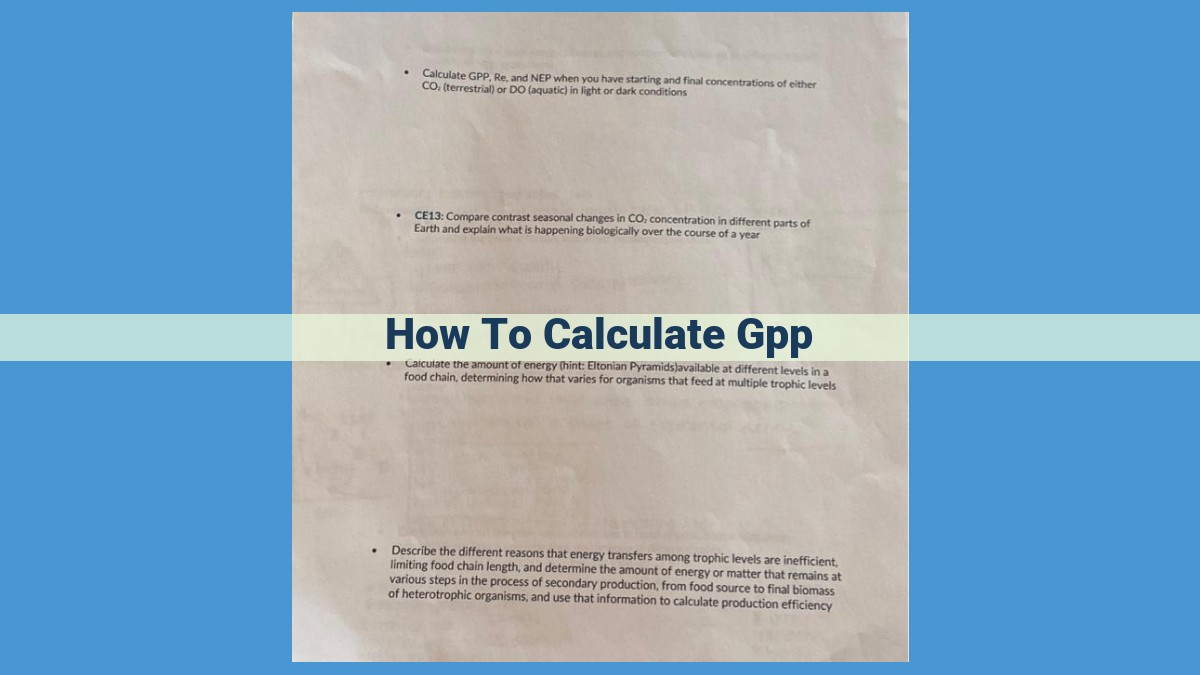GPP (Gross Primary Production) represents the total amount of organic matter produced by plants through photosynthesis in an ecosystem. It can be calculated through techniques that measure carbon dioxide exchange (eddy covariance), chlorophyll activity (fluorescence methods), or vegetation indices and satellite data (remote sensing). These methods provide continuous or periodic estimates of photosynthetic activity, which is crucial for understanding ecosystem dynamics, carbon cycling, and environmental change.
Understanding Gross Primary Production (GPP): A Key Indicator of Ecosystem Health
In the symphony of nature, plants play a pivotal role as the maestros of energy transformation. Through the miraculous process of photosynthesis, they harness sunlight and carbon dioxide to produce oxygen and energy-rich organic compounds, a fundamental process that underpins the entire food chain and sustains life on Earth.
One of the key metrics used to gauge the photosynthetic prowess of ecosystems is Gross Primary Production (GPP). GPP represents the total amount of carbon assimilated by plants through photosynthesis over a given period, providing a snapshot of the ecosystem’s overall productivity and carbon cycling capacity. Understanding GPP is crucial for comprehending the dynamics of ecosystems, assessing their health, and monitoring environmental change.
Understanding the Concepts and Methods Underlying Gross Primary Production (GPP) Calculation
Gross primary production (GPP) is a crucial measure of ecosystem health and dynamics. It represents the total amount of carbon captured by plants through photosynthesis, the process that converts light energy into chemical energy. Understanding GPP calculation involves a comprehension of two key concepts: net primary production (NPP) and ecosystem respiration (ER).
NPP is the amount of new organic matter produced by plants during photosynthesis, excluding the organic matter consumed by plants through respiration. ER, on the other hand, is the process by which organisms in an ecosystem break down organic matter, releasing carbon dioxide back into the atmosphere. The difference between GPP and ER determines the net carbon balance of an ecosystem.
Chlorophyll fluorescence, a phenomenon that occurs during photosynthesis, plays a significant role in measuring GPP. When chlorophyll molecules absorb light energy, they emit a small amount of energy as fluorescence. The intensity of this fluorescence is directly proportional to the photosynthetic activity of plants. By measuring chlorophyll fluorescence, scientists can estimate the rate of photosynthesis and, consequently, GPP.
Techniques for Measuring Gross Primary Production (GPP)
Understanding the health and productivity of ecosystems requires an accurate assessment of gross primary production (GPP). This fundamental measurement quantifies the rate at which plants convert sunlight into biomass through photosynthesis. Scientists rely on various techniques to measure GPP, each with its own advantages and applications.
Eddy Covariance
The eddy covariance method involves measuring the exchange of carbon dioxide (CO₂) between the ecosystem and the atmosphere. Using a tower-mounted sensor, scientists measure CO₂ concentrations and wind speed, allowing them to calculate the net flux of CO₂ over a given area. This method provides continuous GPP estimates, making it suitable for long-term monitoring of ecosystem productivity.
Chlorophyll Fluorescence
Chlorophyll fluorescence measures the activity of chlorophyll, the green pigment responsible for photosynthesis. When chlorophyll absorbs light, it emits a small amount of fluorescence. By measuring this fluorescence, scientists can estimate the rate of photosynthesis and, thus, GPP. Chlorophyll fluorescence can be used for both field measurements and laboratory experiments.
Remote Sensing
Remote sensing techniques utilize satellite imagery and other data sources to estimate GPP. These techniques analyze vegetation indices, which are mathematical combinations of different bands of the electromagnetic spectrum that correspond to vegetation properties. By correlating vegetation indices with field-measured GPP values, scientists can derive GPP estimates over large areas.
Calculating Gross Primary Production (GPP)
Understanding ecosystem dynamics requires measuring Gross Primary Production (GPP), the rate at which plants convert sunlight into organic matter. GPP is the foundation of carbon cycling and ecosystem productivity.
Measuring GPP: A Variety of Techniques
Scientists have developed various techniques to calculate GPP. Each method has its advantages and applications.
Eddy Covariance Method
The eddy covariance method is the most direct approach. It measures carbon dioxide exchange between the ecosystem and the atmosphere. This continuous measurement provides accurate GPP estimates.
Chlorophyll Fluorescence Methods
Chlorophyll fluorescence methods measure chlorophyll activity, which is directly related to photosynthetic activity. These methods are relatively simple and cost-effective, making them suitable for large-scale monitoring.
Remote Sensing Techniques
Remote sensing techniques derive GPP from vegetation indices and other satellite data. This approach provides broad-scale GPP estimates over large areas, but it may be less accurate than other methods.
Importance of GPP in Ecosystem Assessment
Gross Primary Production (GPP), the sum of all photosynthesis occurring within an ecosystem, plays a pivotal role in the intricate web of ecosystem dynamics. GPP is the foundation of carbon cycling, the process that drives the productivity and health of our planet’s ecosystems.
GPP: The Foundation of Carbon Cycling
Through photosynthesis, plants and other organisms convert sunlight into energy used to produce organic matter, a process that consumes carbon dioxide from the atmosphere. This organic matter supports the entire food chain and, ultimately, the very existence of life on Earth. By removing carbon dioxide from the atmosphere, GPP helps regulate the global climate, ensuring a stable environment for all.
Monitoring GPP for Ecosystem Health
Measuring GPP is crucial for assessing the health of ecosystems. Changes in GPP can indicate environmental changes, such as climate variability, pollution, or land-use practices. By monitoring GPP, scientists can track the productivity of ecosystems over time and identify potential threats to their health. For example, declining GPP may indicate ecosystem degradation due to human activities or environmental stress.
GPP monitoring also aids in understanding the response of ecosystems to environmental change. By tracking GPP patterns over time, researchers can identify how ecosystems adapt or succumb to changing conditions, informing conservation and management strategies. GPP monitoring is a valuable tool for ensuring the sustainability of our ecosystems in the face of global change.
